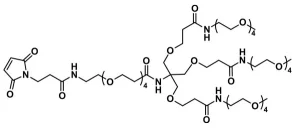MAL-dPEG®12-Tris(-dPEG®24-acid)3, product number QBD-11451, is a thiol- and amine-reactive, four-arm, monodispersed PEG with one arm shorter than the other three. MAL-dPEG®12-Tris(-dPEG®24-acid)3 is a monodispersed branched PEG compound built around a tris core. From the maleimide olefin to carbonyl carbon immediately before the tris core is 46 atoms. From the tris core to the carbonyl carbon on each branch is 83 atoms. The total linker length is 129 atoms. The maleimido group that terminates the short arm of this product reacts with sulfhydryl groups to form thioether bonds. It conjugates directly to target biomolecules.
This product is useful for charge modulation and elimination of renal clearance in drug delivery and imaging applications, among others. The dPEG® spacer length is from the maleimide olefin to the carbonyl carbon on each of the three long arms. The terminal carboxylic acid groups can be modified with various functional or reactive groups (e.g., NHS, TFP esters) or used as-is for charge modulation. In a peer-reviewed scientific publication, this product was shown to alter the biodistribution of the conjugate when used as a charge modulator on the antibody CC49, leading to improved microPET/CT imaging in mice.
| Unit Size | 25 mg, 100 mg |
|---|---|
| Molecular Weight | 4473.17; single compound; |
| Chemical formula | C₂₀₀H₃₈₄N₆O₁₀₀ |
| CAS | N/A |
| Purity | > 95% |
| Spacers | dPEG® Spacer is 130 atoms and 102.4 Å, avg. |
| Shipping | Ambient |
| Typical solubility properties (for additional information contact Customer Support) | Methylene chloride, DMAC or DMSO, water or Acetonitrile. |
| Storage and handling | -20°C; Always let come to room temperature before opening; be careful to limit exposure to moisture and restore under an inert atmosphere; stock solutions can be prepared with dry solvent and kept for several days (freeze when not in use). dPEG® pegylation compounds are generally hygroscopic and should be treated as such. This will be less noticeable with liquids, but the solids will become tacky and difficult to manipulate, if care is not taken to minimize air exposure. |
Greg T. Hermanson, Bioconjugate Techniques, 3rd Edition, Elsevier, Waltham, MA 02451, 2013, ISBN 978-0-12-382239-0; See Chapter 18, Discrete PEG Reagents, pp. 787-821, for a full overview of the dPEG® products.
Site specific discrete PEGylation of 124I-labeled mCC49 Fab’ fragments improves tumor microPET/CT imaging in mice. Haiming Ding, Michelle M Carleton, Stephen P Povoski, Keisha Milum, Krishan Kumar, Kothandaraman Shankaran, George H Hinkle, David Colcher, Rich Brody, Paul D Davis, Alexander Pokora, Mitchell Phelps, Edward W. Martin, and Michael F. Tweedle. Bioconjugate Chemistry. 2013, October 4, 2013. DOI: 10.1021/bc400375f.
Applicable patents and legal notices are available at legal notices.




Stay in the Loop. Join Our Online Community
Products
Ordering
About Us
Application
Resources

©Vector Laboratories, Inc. 2025 All Rights Reserved.
To provide the best experiences, we use technologies like cookies to store and/or access device information. Consenting to these technologies will allow us to process data such as browsing behavior or unique IDs on this site. Not consenting or withdrawing consent, may adversely affect certain features and functions. Privacy Statement
How do I Request a Quote?
To request a quote for products: